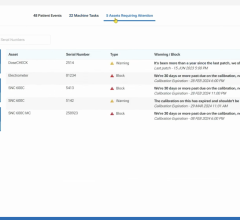May 7, 2009 - With the American Recovery and Reinvestment Act set to spur their development and implementation, electronic health records (EHRs) are getting a lot of attention while businesses like Google and Wal-Mart have begun to develop their own EHR tools.
Because of their potential to improve care and clinical research, NCI and the American Society of Clinical Oncology (ASCO) are collaborating to bring EHRs to community hospitals and centers where most cancer patients receive their care. Under the collaboration, NCI and ASCO are establishing specifications for an oncology-specific EHR that will rely on caBIG standards for interoperability.
The specifications, expected to be completed later this year, are being developed based on open standards in use in the oncology community. The EHRs developed based on these specifications, which may come from industry, NCI, or both, will then be deployed to participants in NCI's National Community Cancer Center Program.
The widespread adoption of EHRs, however, involves "huge challenges," acknowledged Dr. David Blumenthal, the National Coordinator for Health Information Technology. As a recent study he led documented, less than 2 percent of U.S. hospitals have a comprehensive EHR system in place. Cost, the study found, was the biggest obstacle to adoption.Despite some of the problems reported to date with EHRs, evidence is emerging that they can improve the quality and efficiency of medical care. For example, the relatively new EHR system at the University of Arkansas for Medical Sciences (UAMS) has made many aspects of delivering care “so much better,” said Dr. Laura Hutchins, director of Hematology/Oncology at the UAMS Winthrop P. Rockefeller Cancer Institute. While the system is not perfect, she continued, "I don't know of anybody here who wants to go back to a paper record. In addition to saving money, she explained, the system has generally made patient visits more efficient—for example, streamlining the search for information that can influence diagnosis or treatment.
Whereas the UAMS system is still in its early days, the EHR system at the University of Pittsburgh Medical Center (UPMC) dates back to 1991. The center recently completed the first phase of an "interoperability initiative" intended to eventually provide staff at 20 hospitals and more than 400 physician offices and outpatient sites access to what Dr. Daniel Martich, UPMC's chief medical information officer, calls a "full-fidelity" EHR system, an integrated network of patient records with data on everything from admissions to allergies to recent imaging studies. While access to a number of EHR-related tools, such as electronic prescribing, still varies, he explained, the goal is a widely accessible EHR system that "provides a unified view of what's going on with the patient."
Importantly, EHR systems are beginning to demonstrate their utility in research. At UPMC, for example, they have conducted studies showing that, with the addition of clinical prompts, the EHR system reduced the risk of patients receiving an overdose of acetaminophen and improved by fivefold the number of patients notified by their primary care physicians that they may be candidates for clinical trials. Dr. Hutchins and colleagues at UAMS, meanwhile, used their EHR system to evaluate vitamin D levels in women with metastatic breast cancer who received bisphosphonates to treat bone pain and osteoporosis, finding that vitamin D supplements were being underprescribed, which can affect patient outcomes.
The success of EHRs, Dr. Martich believes, will be measured by the extent to which they can be effectively integrated into clinical care and research systems. "The real issue [with EHRs] isn't a technological one," he said. "The question is: How do they function within the workflow of a healthcare system?"
For more infornmation: www.cancer.gov


 November 11, 2025
November 11, 2025 









